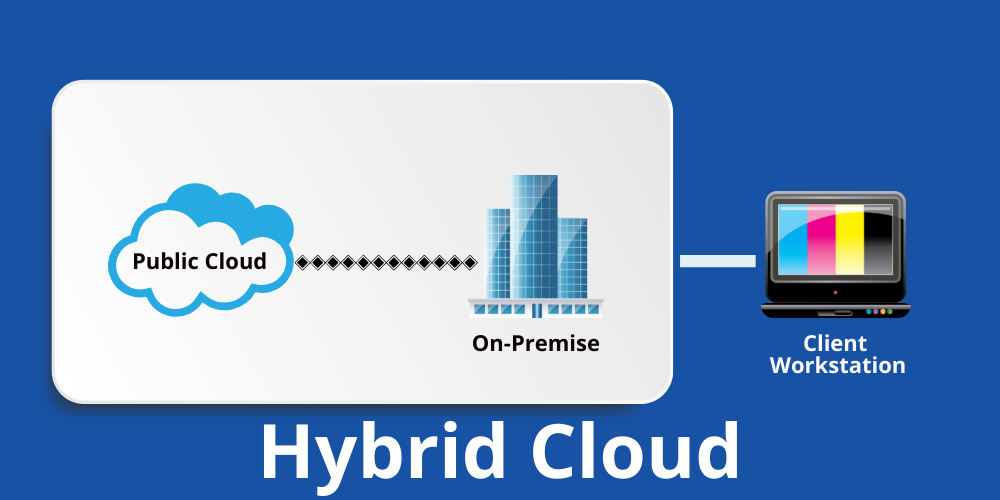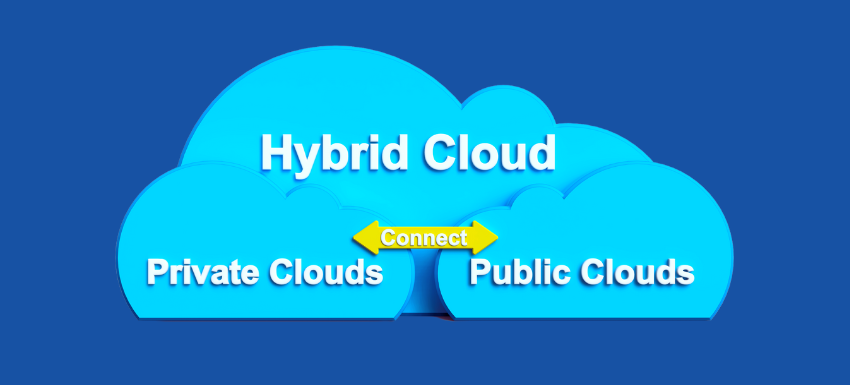The hybrid cloud is the framework for implementing cost-effectiveness and utilization of computing infrastructure based on on-premise and cloud resources.
Your business’s need for computational power increases when you scale up. Similarly, regulations and security concerns also go up. Hence, you may not want to rely exclusively on one technology for business data processing.
From this concept, cloud and on-premise computing services providers invented the hybrid cloud computing model. It is highly successful. If you need to make the cloud transformation now, read the article till the end.
What Is a Hybrid Cloud?
The hybrid model for cloud computing is simply an architecture of computational infrastructure. It can seamlessly interlink a public cloud, private cloud, and on-premise resources for the best outcome from cloud computing.
For a few years, experts have considered the public cloud a cheap, lucrative, but less secure cloud platform. On the other hand, the private cloud is costly but highly secured. Some also consider moving data or workloads from one to another troublesome.
However, the structured growth of hybrid cloud theory and some modern tools made the networking between private and public clouds possible. Now, data can move seamlessly on-premise, private, and public clouds as the business operation demands.
Modern tools that contribute heavily to this novel cloud computing infrastructure are:
- Operating system virtualization using VMware, VirtualBox, Parallels, XenServer, etc.
- Docker, BuildKit, Podman, Containers, etc., function as the container platforms needed to execute containerized apps.
- Virtual networking and access to cloud assets from any region through virtual private networks (VPNs).
The hybrid model lets service providers offer end users zero-latency and zero-downtime of apps and services. It also enables businesses to choose which data to be processed on the public and private cloud.
It is the only framework businesses can leverage to sync legacy infrastructure with IaaS service providers like Google Cloud, Microsoft Azure, and Amazon Web Services (AWS).
How Does Hybrid Cloud Work?
The working or construction of a hybrid system is quite simple. A few virtual assets and sometimes on-premise infrastructures connect. A networking system facilitates connectivity. And at the consumer, employee, and management end, there are a few APIs that let the operators program or execute tasks.
The Architecture
The most prevalent hybrid system integrates on-premise computing resources with a public cloud asset. The business can move workloads to the public cloud at an increasing rate when users increase. And again, if the number of users decreases, you can reduce the public cloud workloads by moving data to on-premise.
Sometimes, you can combine public and private clouds in a hybrid system. You can control the hybrid system from an on-premise workstation while executing sensitive workloads on the private cloud. Customers will mainly use the public cloud to utilize your apps or services.
Technology Resources

At the front, you need a technology to integrate all the data that moves from on-premise to cloud and back. That technology should also offer robust version control so that you can keep several copies of the same data or merge them all.
Secondly, network connectivity is a must. It allows data to move from one environment to another. Instead of raw internet, experts rely more on intranet networks and VPNs for the private or public cloud interfaces.
Thirdly, all hybrid systems need multiple central control interfaces. Here, your business apps will use APIs to call functionalities from other apps or databases on the cloud infrastructure.
Benefits of Using the Hybrid Cloud Model
The hybrid cloud computing model lets enterprises migrate their front-end applications to the cloud, then put other applications on VMs. It also lets you maintain legacy on-premises applications that you cannot move to the cloud due to regulatory or other issues.
Zero-Downtime on Maintenance
When you upgrade your online apps or services, your customers do not need to see an under-construction app or website. You can replicate the existing app’s source code and upgrade it in a containerized environment. When you are ready, simply publish the latest app.
Compliance

Companies looking for better data protection and compliance level find this cloud computing model helpful because it lets the businesses store their more sensitive workloads onto air-gapped repositories in the hybrid system.
On-Demand Scalability
These days, many companies start small and scale up as their businesses grow. The hybrid architecture allows IT admins to scale storage capacity and performance depending on their growing needs.
Reduced IT Workload
Hybrid cloud models enable developers and LOB application owners to handle more requests through self-service. Thus, IT staff need to deal with fewer repetitive tasks related to VMs or containers.
Cost-Effective
Enterprises using a hybrid cloud model can use cost-efficient pay-as-you-go for data backup, business continuity, disaster recovery, and long-term archival.
Flexible Business Transformations
Hybrid systems let you transform business objectives in a few hours. You can reduce legacy workloads or move them to on-premise and increase a new workload whenever you change the product or services.
Reduce Ambiguity
Hybrid systems usually deploy the same OS across environments. Hence, the IT team can quickly troubleshoot, perform maintenance, and upgrade the systems. A constant, same OS also increases the compatibility of security protocols across several cloud assets.
The Structure of a Hybrid Cloud
The hybrid model for cloud computing is a mix of multiple physical and virtual infrastructures like private, public, community clouds, physical computer servers, etc.). All these assets work in synchronization to offer overall processing, storage, and memory power. The architecture could vary with the final application, but common combinations are:
- Two or more public cloud systems.
- Multiple private clouds or virtual private cloud assets.
- Physical server synced to public and private cloud.
- On-premise bare metal or public cloud server connected to a public cloud.

The above are various compositions of various hybrid cloud models. Now, look at the components that form the overall hybrid structure:
Networking
Public, private, and on-premise assets stay connected through a secured network. You need to use VPNs to secure several levels of data connectivity when data and workloads flow between the cloud and local infrastructure.
Full Data and Workload Integration
The hybrid model also needs to control workload and data versions. It does so by integrating public, private, and on-premise data.
Central Management
Mostly, all the environments of a hybrid system use a similar operating system. Linux is the choice of experts since it offers the best security protocols. Various OSs of the hybrid system report to a standard management tool that can alter their capabilities.
Instant Provisioning of Resources
The hybrid system uses a public cloud to quickly access online resources like user profiles, customer accounts, subscriptions, email accounts, etc.
Hybrid Cloud Security

The security of this computing model consists of three separate assets: on-premise, a private cloud, and public cloud infrastructure. The business owner needs to secure both the on-premise and public cloud assets. But they have better control over workloads and data.
On the other hand, the public cloud vendor and the user collaboratively secure the cloud asset. Conventionally, the service provider secures the public cloud infrastructure like data centers while the user installs antivirus and other security elements on their virtual computing asset on the cloud.
Hybrid Cloud Use Cases
Software Development
Launching a new application means dealing with an untested workload with a lot of mystery. While such development companies have to take on a certain amount of risk, using a hybrid model mitigates it to some extent. It allows them to skip the substantial initial investment.
By deploying the new app in a hybrid model, companies can pay only for resources they use instead of paying a lump sum amount in advance. If the development process has to stop in the middle, it will not cost them much.
Regulatory Compliance
Industries with the obligation to protect private data tend to opt for the hybrid system. Especially since the EU introduced General Data Protection Regulation (GDPR), companies doing business in those countries have started to store data in a hybrid model. It lets them comply with GDPR in the EU while adhering to other regulations elsewhere.
The reason behind the popularity of hybrid cloud computing among such organizations is not all data needs storage in a private environment. So, companies can use the private cloud to comply with regulations and the public cloud for the rest.
Highly Changeable Workloads

The need for environment scalability often gives companies a hard time. For example, the current environment might be sufficient to run an application today, but tomorrow, it might need additional computational power.
With hybrid solutions for the cloud, businesses can cater to their ever-changing workload needs and run services smoothly even with changing workload requirements. It works like overdraft protection for your checking accounts to prevent something unexpected.
Digital Transformation
Certain businesses want to modernize their IT infrastructure by moving to a public cloud structure. Unfortunately, they cannot completely shut down private data centers because of legacy applications or compliance obligations.
Such companies find hybrid computing highly beneficial. It allows them to migrate sections of their IT infrastructure to the cloud and keep using some on-premise applications.
Disaster Recovery
With the help of a cloud model of hybrid structure, organizations can duplicate their on-premises workloads and store the data in the cloud for backup purposes. In the event of a disruption in the data center, on-demand cloud resources take over the workloads.
However, organizations should be careful during the implementation to avoid challenges such as high bandwidth consumption and difficulty in data management.
Cloud Data Processing
Another everyday use of hybrid cloud computing is in data processing companies. This infrastructure works as an option to use public cloud services for running analytical queries on on-premise data.
Exploring New Technologies
Sometimes, companies willing to move to a public cloud must try out that platform before the complete migration. For them, a hybrid model is ideal for testing a potential migration.
Usually, the IT team of the company experiments with cloud features and tools on a small scale. Thus, before opting for complete public cloud migration, they know how things work with that particular cloud provider.
eCommerce Sector

Another industry that uses hybrid system storage is eCommerce. These companies have data-intensive high-volume transactions. Moreover, these should also be capable of managing unpredictable workloads during holidays and other seasonal sales. Using this
cloud infrastructure, eCommerce companies can get the necessary scalability and security.
Financial Services Sector
Banking and financial organizations are also opting for hybrid cloud infrastructure. They can utilize the flexible public cloud for new application development and secure private cloud for trading and confidential information storage.
Healthcare Industry
Strict patient data privacy is a significant concern in the healthcare sector. Hence, it sees the usage of hybrid system storage. The private architecture offers a high level of data security. On the other hand, the public cloud allows access to vital clinical information 24/7 to the stakeholders, including insurance providers and healthcare professionals.
Is Hybrid Cloud Right for You?
Since the hybrid model can align business needs with IT priorities, businesses often benefit from leveraging it over other options. Of all the options, it offers maximum flexibility — a significant feature for companies that must adhere to regulatory compliance or want to embrace digital transformation.
A hybrid cloud structure is also perfect for companies with massive data processing requirements and dynamic workloads. Additionally, if your company wants more data security, along with the power of a public cloud, or wants to leverage platform-as-a-service (PaaS) while already being in a private cloud structure, it can choose the hybrid model.
Conclusion
A hybrid cloud simply makes your business more efficient. You can leverage various options like existing on-premise infrastructure, a private cloud, and a public cloud for a combined performance, security, and speed of data-based operations.
You can follow a simple strategy like the one below to manage your data-linked businesses.
Send online apps, subscriptions, and marketing-related tasks to a public cloud. Host intranet websites, billing, customer relations, and confidential data processing on a private cloud. And keep ERP, inventory, company strategies, proprietary apps, and internal communication on-premise.
You may also be interested in Free Resources to Learn about Cloud Computing.
Si quiere puede hacernos una donación por el trabajo que hacemos, lo apreciaremos mucho.
Direcciones de Billetera:
- BTC: 14xsuQRtT3Abek4zgDWZxJXs9VRdwxyPUS
- USDT: TQmV9FyrcpeaZMro3M1yeEHnNjv7xKZDNe
- BNB: 0x2fdb9034507b6d505d351a6f59d877040d0edb0f
- DOGE: D5SZesmFQGYVkE5trYYLF8hNPBgXgYcmrx
También puede seguirnos en nuestras Redes sociales para mantenerse al tanto de los últimos post de la web:
- Telegram
Disclaimer: En Cryptoshitcompra.com no nos hacemos responsables de ninguna inversión de ningún visitante, nosotros simplemente damos información sobre Tokens, juegos NFT y criptomonedas, no recomendamos inversiones


